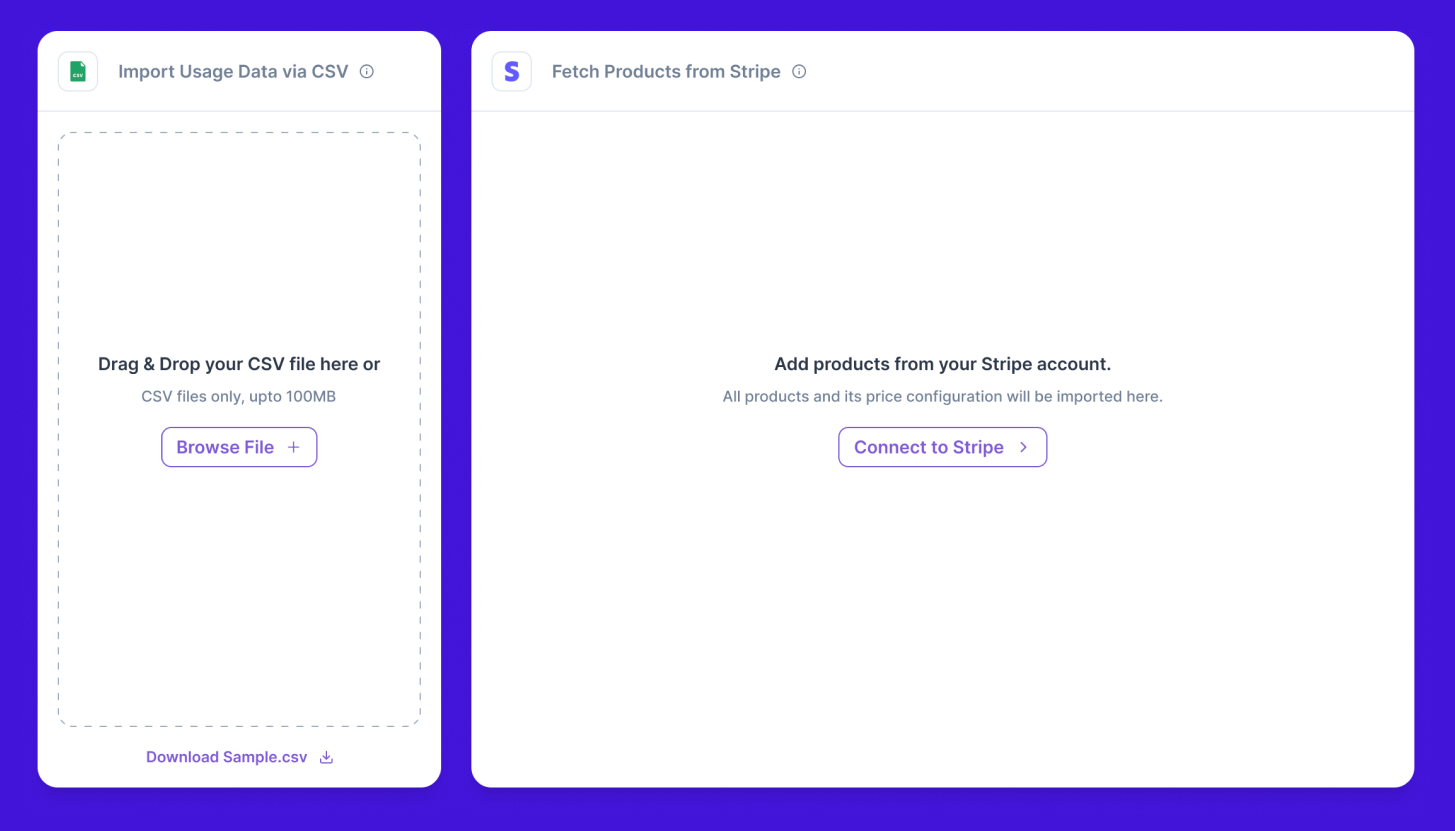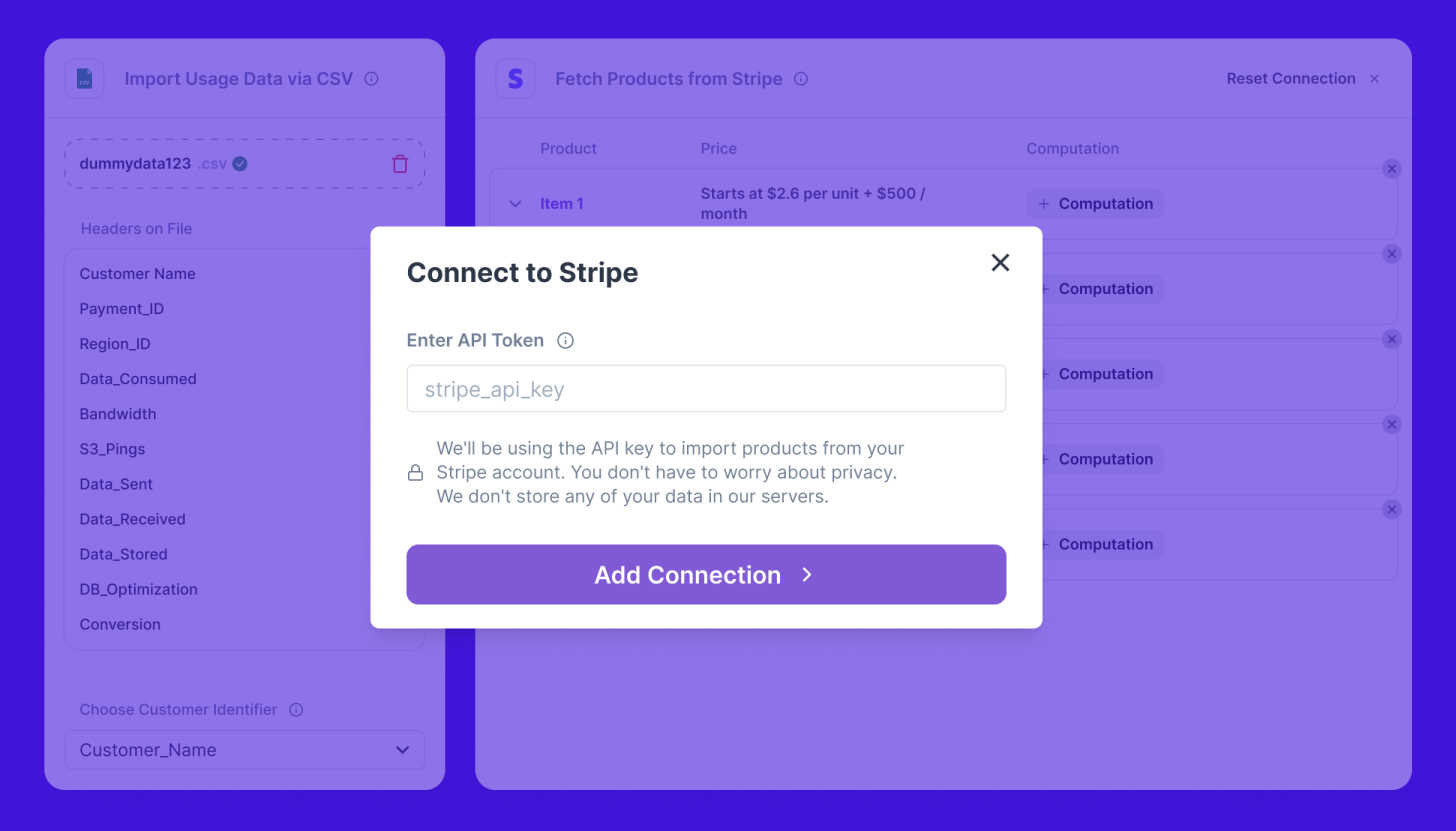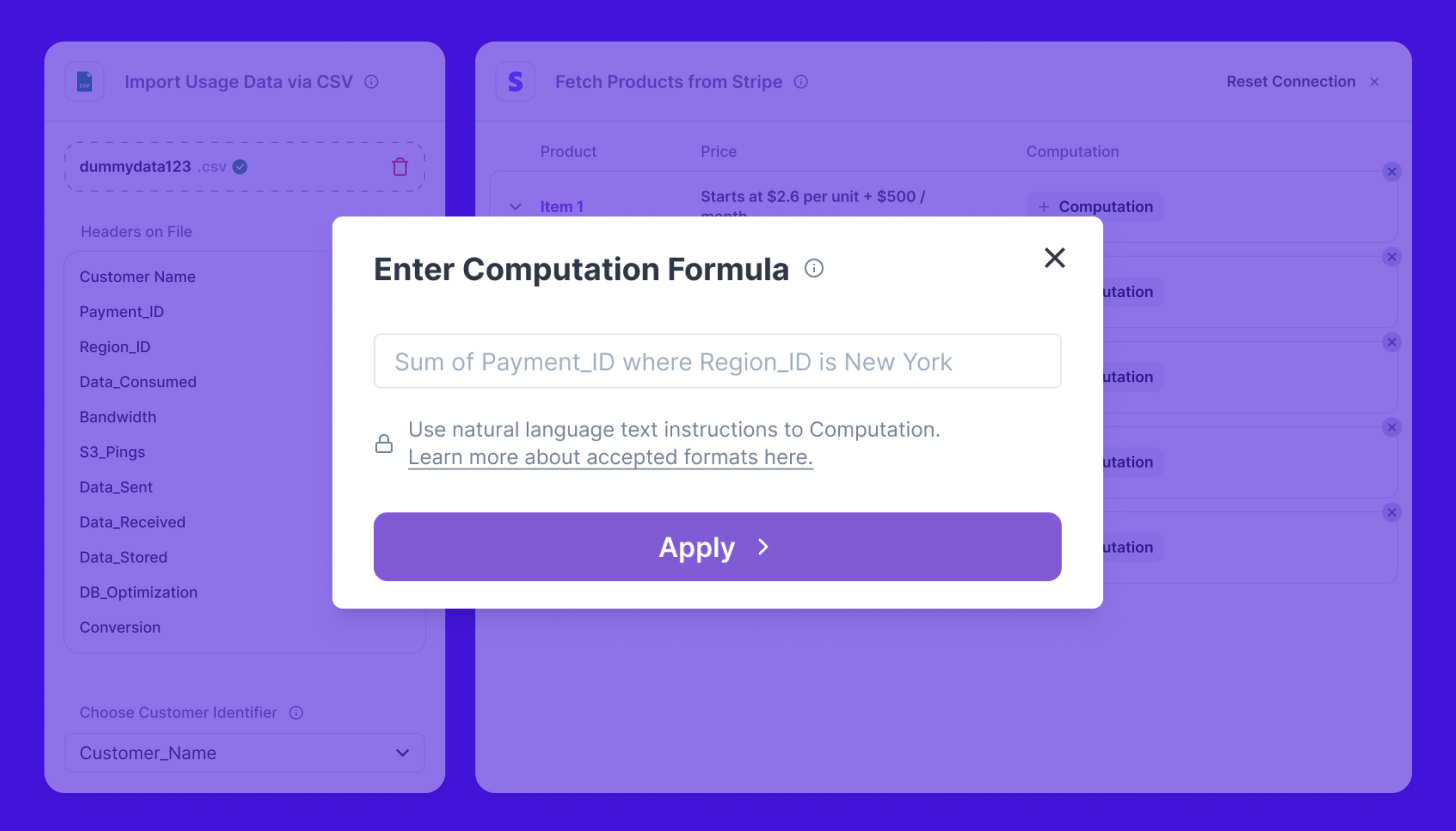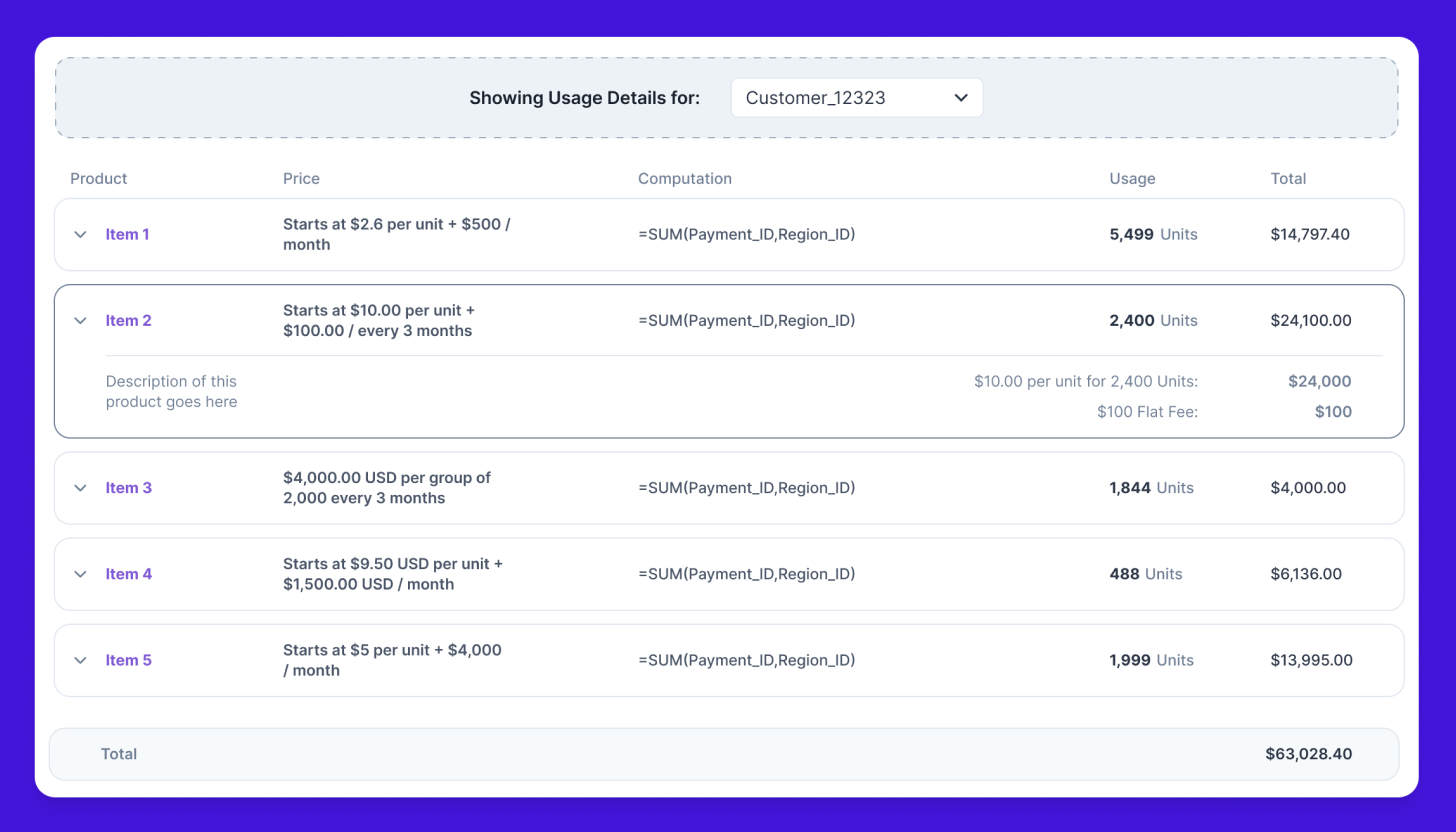



Today those are done in messy spreadsheets. This means a ton of periodic, manual grunt work and a very real possibility of errors, leading to billing disputes.
So this is for you if:
We don’t save any of your data. So it’s fully secure.
Yes! Download it in CSV format from whatever tool you use and upload it to metering.ai.
In order to take in your product and price information, we need to access your Stripe. We then combine that and your usage data to calculate the final values. You can either download that or push it to Stripe.
Most excel formulas are supported in here. Click here to see a comprehensive list.
Metering.ai is a complete no-code tool to convert your raw usage data into metered aggregated values and push them into Stripe for invoicing. We had mentioned in detail the problems with Stripe metered billing here and why we built it here. In this blog, we explain how you can implement 5 common usage based pricing models using metering.ai
1. Count of API hits for a communications API company
If you are a API first company (eg: Twilio) and are pricing your platform based on the number of API hits - say 0.5$ per API request, you can simply upload your API usage log file into metering.ai and add the formula = count (API_request_id) , if your request_id is numeric value format = counta (API_request_id) , if your request_id is string value format
2. Percentage of total payment value for a fintech payments company
If you are a fintech company processing payments and charge your customers a commission based on a percentage of the total payment value processed, similar to Stripe, you can upload your customer wise payment value data and configure metering.ai as:
= sum(total_payment_value) * commission_percentage_value
This will directly give the output as the total commission revenue for your business.
3. Marketing automation product / customer data platform that charges based on monthly active users
We support any type of transformation and aggregation that Excel supports off the bat. In this case, if you are looking to meter the number of monthly active users for each of your customers and price based on that, you can simply use the below formula in metering.ai:
= countunique(user_id)
If you note here, we pull all your product and pricing details as is from Stripe without you having to manually configure anything on metering.ai. In the 1st two examples, we showed a standard pay-as-you-go pricing model which is charged on a per API hit or % of payment value processed.
However, in this example, we show a graduated pricing model (platform fee upto a certain usage limit and overages beyond that) being used in Stripe, and metering.ai handles it seamlessly.
4. Cloud infrastructure company that prices based on compute hour
For a cloud infrastructure company that has a pricing based on the total hours for which an instance was running during the month, there needs to be some instrumentation done to meter and send usage pulses periodically to a metering system. While you can use Togai for this and do the aggregation on top, metering.ai can also be used standalone to input your raw usage pulse events and apply your price transformations on the usage data and push them to Stripe for invoicing your customers and collecting payments.
In this example, we have a file where the usage data is collected every hour as microhour units but as a negative value due to some instrumentation issue. The pricing for this product is counted as the total number of credits that are metered multiplied by the price per credit, which is 3.2$ and maintained in Stripe.
The formula in metering.ai will be:
= abs(sum(ComputeMicroHour)*0.0036/3600))
5. Applying conditions and filters via metering.ai
In this example, we will explain how you can also configure metering.ai and apply different filter conditions to generate your invoices accurately on Stripe with absolutely zero code.
Here, we have 2 pricing models on Stripe - one for a customer on a basic plan and another is a premium plan with additional features and capabilities. The pricing is metered in both plans but the price per unit configured in Stripe varies.
The usage file consists of a column which has a flag (YES/NO) that says whether the customer is on a Premium plan or not. As you can see, by connecting to Stripe, both the plan details are pulled automatically.
Now we configure the formula with the filter condition as follows:
Basic plan customer: =sumif(Premium User,"=NO",Total usage in seconds)
Premium plan customer: =sumif(Premium User,"=YES",Total usage)
Here, you can additionally note that the usage fields used for both plans are different - this is another feature supported by metering.ai and you can have any number of usage and filter fields in your raw usage file and use them to apply your conditions.
Once the filters are applied, you can preview the output and then push the data to Stripe automatically for invoicing.
Metering.ai is an add-on product to your billing system - be it Stripe/Zuora/Chargebee/Recurly or even Togai, we help you meter any type of raw usage data with zero engineering effort and no code. Using Metering.ai you can now forget about inaccurate invoicing and long manual hours spent billing your customers. This tool helps you model any type of pricing use case in just 3 clicks, and best of all - it is completely free !!!
If you have any questions, please feel free to write to aravind@togai.com or reach out to us via our Chat support.
If you are a B2B SaaS company facing challenges in converting your usage data into an invoice on different billing platforms including Stripe, Zuora, Chargebee or Recurly, Metering.ai is meant for you. We understand that maintaining 100s of Excel or Google sheets is not what you want to be doing. We also know that you do not want to be spending your valuable time doing manual work converting this raw data into a format that is accepted by your billing system. If you spend tens of hours every month manually aggregating and transforming your usage data into metered values that your billing system requires, Metering.ai will remove that work completely from your plate.
Let me paint a picture for you - You are a product manager, a finance executive or a customer success manager at an early stage fast growing B2B SaaS company called Flack. You joined Flack hoping to learn and grow from doing a 0 → 1 journey. You are bristling with creative ideas and cannot wait to execute them. Life is good!
You have solved a core need for your users and can see the initial signs of product-market fit. Customers are pulling your product and it is just flying off the shelves. Wow amazing, right? If only, it was this easy 😣You launch a new feature that most customers ask and suddenly your engagement metrics fall drastically. That must have been a rude shock? How come a feature that majority of your users asked for leads to drop-offs? You then realize you missed instrumenting that feature and are unable to track the metrics and funnel for that feature anf a few others launched before too. (As they say, you need data only when things break 🙂)
You painstakingly instrument every little thing in your product and start collecting all sorts of metrics. Now, you identify the issue with that feature and realize it was a simple validation issue with one form. You go ahead and fix it and everything is rosy once again? Well, you start to get the picture now.
Next, you decide to start your monetization and get customers to pay. You do all the work and understand the willingness to pay and come up with a beautiful 3x3 matrix of customer segments with their corresponding pricing and packaging design with a hybrid pricing model that relies on actual usage, because that is the value metric your customers see. Only thing left - set it up on Stripe and start seeing the cash tap flow.
Till now, you have been working on game-changing and high impact ideas that have moved the needle for your business and customers. You took care of strategy and execution and can see your 5 year path with the startup ahead and cannot wait to get to the next level. Then at the end of the 1st month after you start monetization, you face the music - early stage fast growing startups are pure chaos. You pre-empted it but not to the extent that you see there. And the faster the startup grows, more does the chaos.
What does this mean for you? While the price plans were setup on Stripe, you did not think what would happen when payments had to be collected? So, you end up manually pulling the usage data from all metering system or analytics tool and collate it in an Excel. Then, you export all the price plan, product and package information from Stripe. Then you do some magic and automate everything without worrying about accuracy of your invoices. (oh sorry, we skipped to the part where you use metering.ai to do the magic).
In reality, you end up spending 20+ hours of Vlookups, Pivot Tables, Row and Column transformations on Excel/Google Sheets and then painstakingly update all this information on your Stripe account. 20+ hours that you could be spending on actual strategic things that move the needle for your business and you spend it on operating important, but unnecessary grunt work that makes you sigh - ‘It’s 2023, we have ChatGPT and general AI, but not a tool that converts my raw usage data into metered usage and push it automatically into my billing system’.
Well, metering.ai is that tool and as a builder, having faced this exact same problem myself, I cannot wait for everyone who faced this problem to use it. And the best part - it is completely free. What we are asking for is 15 minutes of your time and understand how we can solve it for you. Please feel free to write to aravind@togai.com or reach out to us via our Chat support, or if you prefer having a chat - you can book a time on my calendar here. Happy metering!!!
Introduction
The SaaS landscape is increasingly adopting usage-based pricing models, making it essential to track product usage accurately and ensure error-free billing. Stripe Metered Billing is an excellent solution that allows businesses to charge customers based on their usage of products or services. However, implementing Stripe Metered Billing can be complicated, particularly when it comes to aggregating data and connecting it to the billing system. That's where Togai's Metering.ai comes in. In this article, we'll discuss how Metering.ai, a no-code metering tool, simplifies Stripe Metered Billing, enabling businesses to launch new pricing models effortlessly and eliminate billing errors without involving engineers.
The Growing Importance of Stripe Metered Billing in SaaS
Stripe Metered Billing is a powerful and flexible billing solution that enables businesses to charge customers based on their actual product usage. This billing model is ideal for companies offering usage-based pricing, such as cloud storage providers, streaming services, or any SaaS businesses. By adopting Stripe Metered Billing, businesses can create customized billing structures that ensure fair and accurate customer charges.
Overcoming the Challenges of Implementing Stripe Metered Billing
Despite its many advantages, implementing Stripe Metered Billing can be a daunting task. Connecting usage data to the billing system and aggregating it often requires significant engineering effort and a deep understanding of the software. This can be particularly challenging for smaller businesses or those with limited resources.
Introducing Metering.ai: Togai's No-Code Metering Solution for SaaS Billing
Metering.ai is Togai's innovative no-code metering tool designed to simplify Stripe Metered Billing. This groundbreaking solution allows non-engineers to easily aggregate usage data and connect it to Stripe without any coding expertise. In just three clicks, Metering.ai transforms product usage data into Stripe invoices, eliminating the need for engineering effort.
How Metering.ai Streamlines Stripe Metered Billing for SaaS Businesses
Metering.ai offers numerous benefits for businesses looking to implement Stripe Metered Billing:
Hassle-free Data Aggregation: One of the main challenges of implementing usage-based pricing in Stripe is aggregating the data. Metering.ai addresses this issue by providing a no-code platform that effortlessly aggregates usage data, without involving engineers.
Minimal Effort: Metering.ai is designed for non-engineers, enabling product managers or founders to set up and manage the system with ease. Its user-friendly interface ensures that anyone can navigate and comprehend the system.
Seamless Data Integration: Metering.ai applies transformations and aggregations on top of usage data, ensuring accurate connection to your billing system. This eliminates the need for complex Excel calculations and reduces the risk of billing errors and disputes.
Flexible Pricing Models: With Metering.ai, you can quickly experiment with and launch new pricing models based on usage data. This empowers you to optimize your revenue and provide better value to customers.
Scalability: As your business expands, Metering.ai scales with you, guaranteeing an efficient and accurate billing system.
Getting Started with Metering.ai for Streamlined SaaS Billing
To begin using Metering.ai for Stripe Metered Billing, follow these simple steps:
Sign up for a Togai account.
Connect your product usage data to the Metering.ai platform.
Configure your desired pricing and billing workflows.
With just three clicks, transform your product usage data into Stripe invoices.
Conclusion
Implementing Stripe Metered Billing has never been easier, thanks to Togai's Metering.ai. This no-code metering solution removes the need for extensive engineering effort and allows non-engineers to manage
